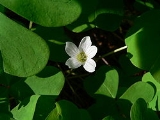
Redwood sorrel
Encyclopedia
Oxalis oregana is a species of the wood sorrel family, Oxalidaceae
, native to moist Douglas-fir
and Coast Redwood forests of western North America
from southwestern British Columbia
, Washington, Oregon
, and California
.
 Oxalis oregana is a short herbaceous
Oxalis oregana is a short herbaceous
perennial plant
with erect flowering stems 5–15 cm tall. The three leaflets
are heart-shaped, 1-4.5 cm long with purplish undersides, on 5–20 cm stalks. The inflorescence
is 2.4–4 cm in diameter, white to pink with five petals and sepals. The hairy five-chambered seed
capsules are egg-shaped, 7–9 mm long; seeds are almond shaped.
, probably in small quantities, since they contain mildly toxic oxalic acid
, whence the genus name.
Oxalidaceae
The Oxalidaceae, or wood sorrel family, are a small family of eight genera of herbaceous plants, shrubs and small trees, with the great majority of the 900 species in the genus Oxalis...
, native to moist Douglas-fir
Douglas-fir
Douglas-fir is one of the English common names for evergreen coniferous trees of the genus Pseudotsuga in the family Pinaceae. Other common names include Douglas tree, and Oregon pine. There are five species, two in western North America, one in Mexico, and two in eastern Asia...
and Coast Redwood forests of western North America
North America
North America is a continent wholly within the Northern Hemisphere and almost wholly within the Western Hemisphere. It is also considered a northern subcontinent of the Americas...
from southwestern British Columbia
British Columbia
British Columbia is the westernmost of Canada's provinces and is known for its natural beauty, as reflected in its Latin motto, Splendor sine occasu . Its name was chosen by Queen Victoria in 1858...
, Washington, Oregon
Oregon
Oregon is a state in the Pacific Northwest region of the United States. It is located on the Pacific coast, with Washington to the north, California to the south, Nevada on the southeast and Idaho to the east. The Columbia and Snake rivers delineate much of Oregon's northern and eastern...
, and California
California
California is a state located on the West Coast of the United States. It is by far the most populous U.S. state, and the third-largest by land area...
.
Description

Herbaceous
A herbaceous plant is a plant that has leaves and stems that die down at the end of the growing season to the soil level. They have no persistent woody stem above ground...
perennial plant
Perennial plant
A perennial plant or simply perennial is a plant that lives for more than two years. The term is often used to differentiate a plant from shorter lived annuals and biennials. The term is sometimes misused by commercial gardeners or horticulturalists to describe only herbaceous perennials...
with erect flowering stems 5–15 cm tall. The three leaflets
Leaf
A leaf is an organ of a vascular plant, as defined in botanical terms, and in particular in plant morphology. Foliage is a mass noun that refers to leaves as a feature of plants....
are heart-shaped, 1-4.5 cm long with purplish undersides, on 5–20 cm stalks. The inflorescence
Inflorescence
An inflorescence is a group or cluster of flowers arranged on a stem that is composed of a main branch or a complicated arrangement of branches. Strictly, it is the part of the shoot of seed plants where flowers are formed and which is accordingly modified...
is 2.4–4 cm in diameter, white to pink with five petals and sepals. The hairy five-chambered seed
Seed
A seed is a small embryonic plant enclosed in a covering called the seed coat, usually with some stored food. It is the product of the ripened ovule of gymnosperm and angiosperm plants which occurs after fertilization and some growth within the mother plant...
capsules are egg-shaped, 7–9 mm long; seeds are almond shaped.
Light response
Redwood sorrel, Oxalis oregana, photosynthesises at relatively low levels of ambient light (1/200th of full sunlight). When direct sunlight strikes the leaves they fold downwards; when shade returns, the leaves reopen. Taking only a few minutes, this movement is observable to the eye.Food
The leaves of Oxalis oregana were eaten by Native AmericansIndigenous peoples of the Americas
The indigenous peoples of the Americas are the pre-Columbian inhabitants of North and South America, their descendants and other ethnic groups who are identified with those peoples. Indigenous peoples are known in Canada as Aboriginal peoples, and in the United States as Native Americans...
, probably in small quantities, since they contain mildly toxic oxalic acid
Oxalic acid
Oxalic acid is an organic compound with the formula H2C2O4. This colourless solid is a dicarboxylic acid. In terms of acid strength, it is about 3,000 times stronger than acetic acid. Oxalic acid is a reducing agent and its conjugate base, known as oxalate , is a chelating agent for metal cations...
, whence the genus name.

